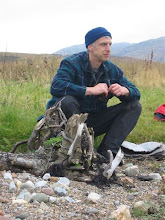




A couple of weeks ago I had my first moth night for the year. So what is a "moth night " ? Well it involves setting up a moth trap in a place where you think that the species that you want to find out about live. And a moth trap ? Well it is like an electric lobster pot, it has a bright light that atttracts in the moths, a narrow gap that they fly in and a large chamber that is difficult to fly out of again so they settle down in the comfortable egg boxes provided until the trap in emptied in the morning.
The area chosen for the moth trap this night was on a far off corner of the reserve so once the trap was set running after sunset it wasn't worth me going home so I spent a surprisingly comfortable night in the back of the works truck. At 0530 I was back on the Moss on a overcast, murky, damp morning. All sorts of disasters can befall a moth trapping night, the generator (that provides the power for the lamp) failing or a bulb blowing or just not the right weather for moths. So there is an incredible sense of anticipation as you walk down to the trap. Firstly the overcast but muggy night was a good sign, perfect moth weather, next the genny was still running, another good sign and then when I got to the trap there were moths all around it, settled onto the vegetation once daybreak had broke, brilliant, I was in business.

The next 2 hours went incrediblely quickly. I was in the zone, emptying the trap and catching the moths around it, identifying them using my sketchy knowledge and the moth bible, Waring and Townsend and recording and photographying the details.
In the end 110 moths were recorded of 28 species and I didn't have the time to check all of the tiny "pugs" that are so difficult to identify. Best of all was a birch mocha, never recorded on Flanders before and only recorded in the central scotland area 5 times before. Moths have such beautiful names and of those I caught that morning the lunar thorn, the miller, pebble hook-tip, pale-shouldered brocade, nut-tree tussock and red-sword grass stand out. And the clouded drab sounds better than it looks. But for many even the names don't do them justice, some like the emperor moth with its eyes are too showy for words, others like the pale prominant look more like a stick than a stick does.
So in the next week i will be out there again for another hit of moth adrenaline followed by the satisfaction of puzzling out each one caught. I'll keep you posted.

 inter would have been especially hard for them.
inter would have been especially hard for them.














































